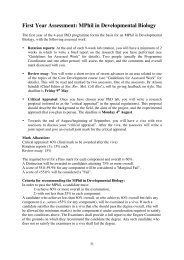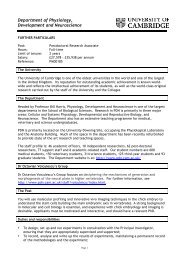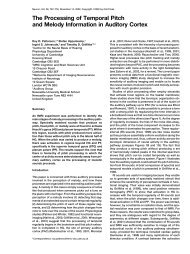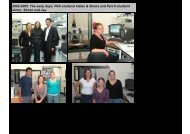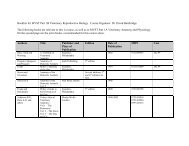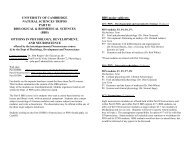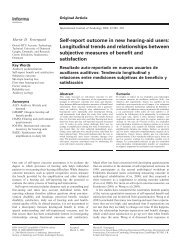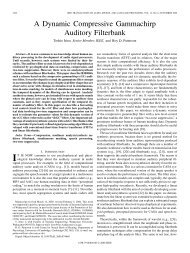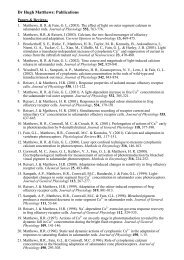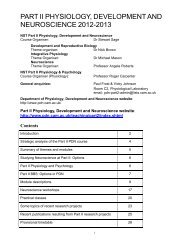FRIDAY MORNING, 20 MAY 2005 REGENCY E, 8:30 A.M. TO 12:00 ...
FRIDAY MORNING, 20 MAY 2005 REGENCY E, 8:30 A.M. TO 12:00 ...
FRIDAY MORNING, 20 MAY 2005 REGENCY E, 8:30 A.M. TO 12:00 ...
Create successful ePaper yourself
Turn your PDF publications into a flip-book with our unique Google optimized e-Paper software.
10:05–10:<strong>20</strong> Break<br />
Contributed Papers<br />
10:<strong>20</strong><br />
5aSP4. Acoustic self-localization of a wireless sensor network. Peter<br />
L. Schmidt, Stephen M. Williams, and Kenneth D. Frampton Vanderbilt<br />
Univ., 24<strong>00</strong> Highland Ave., Nashville, TN 372<strong>12</strong><br />
One of the biggest challenges to the field of wireless sensor networks<br />
is self-localization: that is the determination of the relative and absolute<br />
coordinates of each sensor node in the network. Previous work has been<br />
done to locate hydrophone arrays. However sensor networks have some<br />
unique constraints that make this more challenging. A typical application<br />
would involve the distribution of hundreds or thousands of sensor nodes<br />
over an area either by hand, airdrop or other means. One of the primary<br />
constraints on such a system is that centralized processing of selflocalization<br />
data may be prohibitively complex. Furthermore, the data may<br />
be incomplete, contain reflected path events, and may be subject to other<br />
mission specific constraints. Therefore, a distributed computational<br />
scheme has been developed to solve acoustic time-of-arrival equations. A<br />
priori information about some sensor locations and user triggered source<br />
localization events are used along with a regularized inversion solution.<br />
Results of this will be presented based on both small scale experiments<br />
and larger systems simulations. Limits of the types of a priori information<br />
required for accurate results are detailed, along with studies of the accuracies<br />
obtained using various distributed calculations parameters.<br />
10:35<br />
5aSP5. Distributed source localization in a wireless sensor network.<br />
Stephen M. Williams, Peter L. Schmidt, and Kenneth D. Frampton<br />
Vanderbilt Univ., 24<strong>00</strong> Highland Ave., Nashville, TN 372<strong>12</strong><br />
This work concerns experimental implementation of distributed acoustic<br />
source localization with a wireless sensor network. The envisioned<br />
application is the distribution of hundreds or thousands of small, semidisposable,<br />
wireless sensor nodes possibly by airdrop. These nodes<br />
would form an ad-hoc communications network and monitor and track<br />
acoustic events within the array. Centralized processing of such data<br />
would be prohibited by the excessive communications and complexity of<br />
calculations. Furthermore, localization with a network of randomly placed<br />
sensors is not suited to use of traditional array theories due to irregular<br />
placement of sensors and the unknown sensitivity and phase relationships<br />
between sensors. Therefore, a fully distributed localization algorithm was<br />
developed in which nodes organize themselves into groups which collaborate<br />
to locate sources. Acoustic event time-of-arrival information is shared<br />
among group members and the source locations were determined using<br />
Tikhonov regularized inversion. Small scale localization experiments<br />
with 10 sensor nodes were conducted to validate the performance of the<br />
method. Results are discussed, along with limitations of the method discovered<br />
during conduct of the experiments. In addition, a comparison is<br />
made between this method and traditional matrix solution methods.<br />
10:50<br />
5aSP6. Particle filters for tracking a vehicle through a field of acoustic<br />
directional frequency and recording „DIFAR… sensors. Anton J. Haug<br />
The MITRE Corp., 7515 Colshire Dr., McLean, VA 22102,<br />
ahaug@mitre.org<br />
For nonlinear/non-Gaussian processes, Bayesian approaches to tracking<br />
require integration over probability density functions, which cannot be<br />
accomplished in a closed form. Recently, numerical Monte Carlo ‘‘particle<br />
filter’’ integration techniques have been developed and applied to tracking<br />
problems. However, multidimensional application examples of these techniques<br />
have been limited because they require an analytic expression for<br />
the likelihood function, which is usually not easy to obtain when the noise<br />
is non-Gaussian and not additive. Tracking a vehicle through a field of<br />
acoustic DIFAR sensors is such an application. Although the vehicle dynamic<br />
model can be linear with additive Gaussian noise, the observation<br />
model is inherently nonlinear with observations that contain embedded<br />
non-Gaussian noise. For the DIFAR vehicle tracking problem, we will<br />
consider large time-bandwidth signals, develop both the dynamic and observation<br />
models, and show how the Gaussian additive noise on each<br />
DIFAR channel results in non-Gaussian noise embedded in the bearing<br />
observations. The likelihood function will then be presented and the performance<br />
of several particle filter trackers will be compared with that of an<br />
Extended Kalman Filter.<br />
11:05<br />
5aSP7. Source localization in complex scattering environments using<br />
random amplitude and bearing information. D. Keith Wilson, Mark<br />
L. Moran, and Roy Greenfield USACE ERDC-CRREL, 72 Lyme Rd.,<br />
Hanover, NH 03755-<strong>12</strong>90, D.Keith.Wilson@erdc.usace.army.mil<br />
By scattering sound waves, atmospheric turbulence and other outdoor<br />
objects such as building and trees induce random fading and angle-ofarrival<br />
variations in signals received by small-baseline microphone arrays.<br />
This study addresses the relative utility of signal amplitude and bearing<br />
estimates when such variations are present. Source-localization simulations<br />
are performed for four idealized statistical scattering models: no<br />
scattering, weak turbulent scattering, strong turbulent scattering, and diffuse<br />
multiple scattering. Each of these cases is considered with low,<br />
moderate, and high SNR. It is found that bearing information provides<br />
highly accurate source localization when SNR is high and scattering is<br />
negligible. However, when the SNR is low and/or there is significant scattering,<br />
the bearing information loses its utility while the amplitude information<br />
remains relatively robust. Algorithms are considered that attempt<br />
to assess the relative reliability of the bearing and amplitude information,<br />
and subsequently weight signal features to provide the most satisfactory<br />
results. The simulations also confirm previous analyses suggesting that, for<br />
unfavorable propagation conditions and SNR, Cramer-Rao lower bounds<br />
predict substantially better performance than is obtainable in practice.<br />
11:<strong>20</strong><br />
5aSP8. A method for locating nearby sources. John V. Olson, Kenneth<br />
Arnoult, and Curt. A. S. Szuberla Geophysical Inst., Univ. of Alaska,<br />
Fairbanks, AK 99775<br />
A fast method for locating nearby sources based solely on the time-offlight<br />
information is described. The time delays for a signal passing between<br />
all sensor pairs is determined using cross-correlations and a vector<br />
of time delays is constructed. In the noise free case, where the speed of<br />
sound is constant, each point in the plane is associated with a unique value<br />
of the time delay vector. The method we present uses a fast, simplex-based<br />
search of the plane for a source location by minimizing the difference<br />
between the vector associated with the candidate location on the plane and<br />
the value estimated from cross-correlations. The search takes place over<br />
the three dimensional space that includes two coordinates in the plane and<br />
the propagation speed. The starting point for the search is constructed<br />
from an analytic fit of circular wave fronts to groups of sensors within the<br />
array. This method has been useful in identifying near-field sources in the<br />
153US and 155US CTBT/IMS infrasound arrays. Examples of the locations<br />
we have determined along with a description of the statistical confidence<br />
limits associated with the method will be presented.<br />
2610 J. Acoust. Soc. Am., Vol. 117, No. 4, Pt. 2, April <strong>20</strong>05 149th Meeting: Acoustical Society of America 2610



